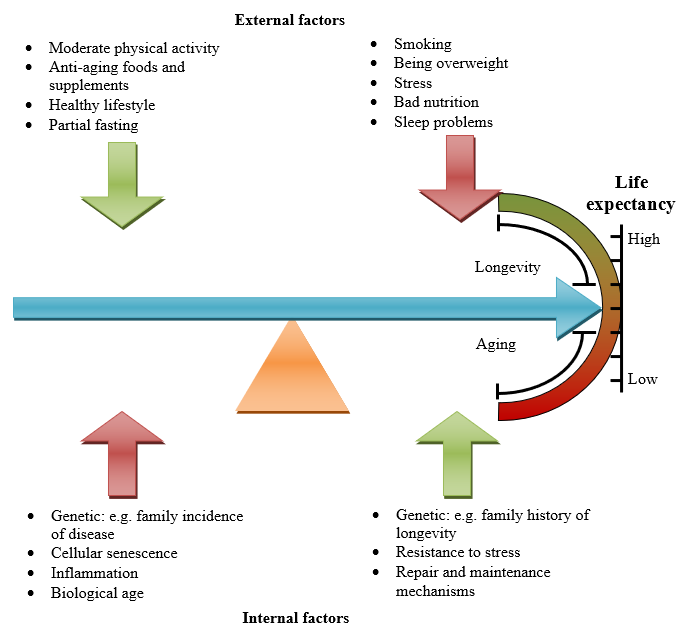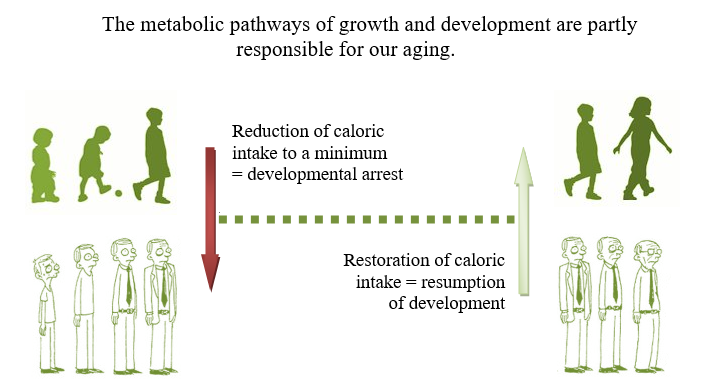
Healthy longevity
Many people believe that aging is an accumulation of wear and tear, errors and genetic failures under the influence of extrinsic and hereditary factors. If that was the case, we could ask ourselves the following questions :
- Why do living organisms, which grow faster, age more quickly? (A mouse that develops in a few weeks will only live for 3 years, on average. An elephant that develops in 18 months can live up to 60 years.)
- Why do certain mammals live a lot longer than other comparable animals? (Bats can live for more than 40 years.)
- Why do certain organisms not age? (e.g.: hydra).
The answers to these questions can be split into two main principles :
- the speed of aging is influenced by metabolic pathways linked to the growth and development that make us age,
- our maintenance and repair abilities can slow down the process.

Here is an example to illustrate the impact of principles a) and b). It is like driving a car at full throttle, while controlling the speed with the brake pedal. The wear and tear on the car would be greater. So, animals with a faster growth rate could age more quickly because of the fact that these metabolic pathways continue to be active after adulthood and promote aging processes.
As for the second principle, if this car undergoes more maintenance (b), it will last a lot longer. So, it has been shown that certain living organisms maintain natural maintenance and repair abilities for a much longer period of time.
To sum up; organisms that age quickly (e.g.: mice) have a sticky pedal situation while those that live a lot longer (e.g.: bats) perform lots more maintenance.
It goes without saying that the best approach would be to lift our foot off the pedal, while increasing maintenance quality and frequency. This is what IDUNN Technologies discovered.
Metabolic pathways
The metabolic pathways of aging have been identified, in large part, from an observation made in 1935. If animals are deprived of 30% of their caloric intake without causing nutritional deficit, they will live 25 to 40% longer. This is called caloric restriction. Unfortunately, it is very hard to apply to human beings; for an adult, this would mean eating like a 5-year-old child who is not very active. This low calorie count would also endanger the organism.
How is this possible? Living organisms learned to slow down development processes (also partly responsible for aging) if the calorie count is minimal or insufficient. So, a malnourished child stops growing. Similarly, an adult eating fewer calories ages more slowly.

Modulation of these metabolic pathways would help shift the use of energy resources from the growth and reproduction function to the maintenance and repair function (Cava and Fontana 2013). What is most interesting is that natural molecules can modulate these metabolic pathways. This is called “caloric restriction mimesis”.
It is therefore possible to:
- slow down the aging process,
- increase our maintenance and repair abilities.
Live healthier and longer
It is important to know that modulating the metabolic pathways of aging not only helps to live longer, but also helps to reduce the incidence of diseases related to aging (cardiovascular diseases, diabetes, osteoporosis, degenerative diseases, etc.), thereby helping people to “Live healthier and longer”.
The metabolic pathways identified through caloric restriction help to increase longevity, not by extending conditions of old-age, weakness or illness for a longer period of time, but rather by preserving the metabolic and biological functions in a state similar to those of a younger organism (Cava and Fontana 2013).
Benefits of caloric restriction :
- Reduction of inflammation
- Reduction of growth hormones
- Better glucose management
- Reduction of body fat
- Decrease in cancer risks
- Preservation of stem cell functions
- Improvement of mitochondrial metabolism
- Reduction of the loss of muscle mass
- Preservation of the cognitive structure and functions
- Reduction of the risk of cardiovascular diseases
(Fontana et al, 2010; Kaeberlein 2013)
Many scientific researchers have already identified the modulation of the metabolic pathways of aging as an approach that can generate one of the greatest impacts on human health (Kaeberlein 2013; Davinelli et al 2012; Baur 2010). Instead of focusing our efforts on treating specific, well-established diseases, interventions dealing with aging processes themselves will have a much greater impact. This preventive approach is also referred to as positive biology.
Depending on various comparison methods, 20 to 25 quality years could be added to human life expectancy. More specifically, this would allow people of 50 years old to have the same physical and cognitive abilities at 70 or 75. This could also translate into 7 – 8 more years on total life expectancy, but it would be the time spent being healthy that would be increased the most.

